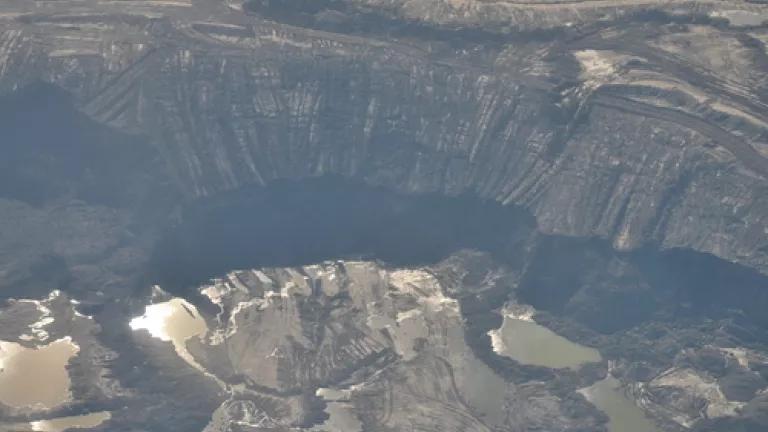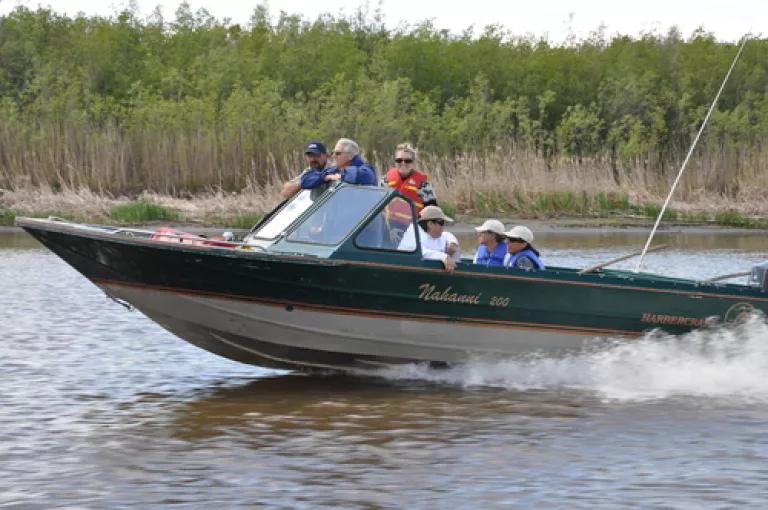
This week, I traveled with staff and members of the NRDC Board and Global Leadership Council to see and hear for ourselves the impacts of tar sands oil extraction in northeastern Alberta. I had read about the tar sands and seen photographs. But it was not until I flew over them from Ft. McMurray to Ft. Chipewyan that I began to understand the vast scale of what we are doing to Canada’s boreal forests and wetlands to get tar sands oil. From the air, I could see that not only did the mines stretch for miles, but they reached deep into the Earth, disturbing hundreds of feet of boreal peatlands that have been a carbon storehouse for centuries.
The tar sands, aerial view.
This fundamental changing of a landscape from delicate bogs, fens, and marshes to open wounds is symptomatic of what oil companies are willing to do to feed our dependence on fossil fuels.
The tar sands operations are far away from their main consumers in the United States. Located in the far northeastern part of Alberta in Canada, they are far away from most Canadians as well. (Indeed, even the people in the area working on the tar sands almost all live or grew up far away.) Most people filling up their car with gasoline have no idea what went into extracting that fuel from deep under the forest. (Just a few impacts, according to Andrew Nikiforuk’s “Tar Sands” book, from filling up with 20 gallons include well over 60 gallons of fresh water diverted from the rivers and wetlands through the process and ending in toxic tailings ponds, at least about 30 gallons of toxic “fine tailings,” and both toxic and climate changing air pollution.)
The reach of the impacts of the tar sands extends far beyond the immediate area impacts of destruction of land that I saw, plumes of air pollution I smelled, and water pollution I witnessed on this trip. After visiting the tar sands on the ground and flying over them, we flew north (downwind and downstream) and listened to stories from Ft. Chipewyan, Ft. Smith and other First Nation communities. They told us about what the tar sands pollution and use of water are doing to the health of the people, land, animals, fish and water – they have been told not to drink the water anymore, to limit their fish intake, that even the animals they hunt may be contaminated. It was shocking beyond words to be so far north in an area that seemed so far away from industrial development and not be able to trust the cleanliness of the environment. I’ve often canoed in areas in Ontario that, although closer to communities and roads, are cleaner because there are no developments on the scale of the tar sands.

Entering the Peace-Athabasca Delta.
This trip allowed me to travel from source (tar sands) to victim (downstream communities and NRDC’s Peace-Athabasca Delta BioGem). Seeing and hearing the devastation caused by melting oil from the tar sands, brought me back to what is now needed more than ever: fuel efficiency and cleaner transportation solutions that do not depend on fossil fuels. When people go to fuel their cars, they should know the scope and scale of what it took to get that oil.
Our first day in the tar sands, NRDC’s President Frances Beinecke was appointed to the BP Deepwater Horizon Oil Spill and Offshore Drilling Commission. We all already had the tragedy of the Gulf disaster in our minds, but this brought it more forcibly home: our dependence on oil has outstripped rational behavior and good oversight when it comes to fossil fuels. While viewing the tar sands, we had in our minds, the specter of offshore oil drilling in the Gulf, oil shale excavation in the U.S. Rockies, mountain-top removal for coal in Appalachia, and irresponsible gas flaring in the excavation of oil in Nigeria. All this suggests that so long as we play three card monte, shifting our use from one source of oil to another, we are using vastly more resources than our planet can support. Is there any real answer but much greater efficiency and conservation?
Clearly, the answer is no. The only chance for the boreal, for the First Nations, for the planet, for the Gulf is reducing the demand for oil. And that can be done by more efficient vehicles, cleaner fuels, and redesigning our communities so we are not so car dependent. More later on those solutions.
